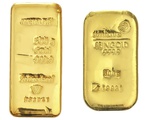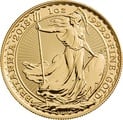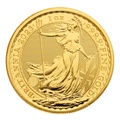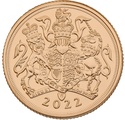How much is gold worth?
Working out how much gold is worth can depend on a number of factors. The constantly changing gold price, the amount of gold, and the form the gold is all in call have an impact on how much gold is worth. Below then we look at some of the things you'll need to consider when working out the value of any gold you have.
How much is gold worth today?
The official price of gold is always changing, meaning that the material worth of your gold bars and coins and even any jewellery you own is constantly fluctuating. Twice each day, at 11:00 and 15:00 GMT, an official ‘fix’ price is set in a series of auctions between a number of leading banks, governed by ICE Benchmark Administration. This official figure is used as a benchmark for the trading of gold and gold based products, although only particularly large deals are made using the fix itself.
The vast majority of sales and purchases of gold are made using the ‘spot’ price, based on over the counter demand and availability for the precious metal. It is the spot price, rather than the gold price, that is most likely to reflect the value of any bar or coin that your purchase, although the two will usually be fairly close.
The spot price is published in USD, EUR and GBP and is usually stated in troy ounces - around 31.103g. The spot price then is considered to be the market worth for a troy ounce of gold in unrefined form. Find out
how much gold is worth today
with our interactive price charts.
Calculating how much a specific gold bar or coin is worth, then, is rather straightforward and depends on just two things; the movements of the gold spot price and, of course, the size and purity of the item in question.
The standard bar traded by banks and bullion dealers is the London Bullion Market Association (LBMA) Good Delivery bar, which weighs around 12.5kg in weight. According to the LBMA Good Delivery Rules, a gold bar must contain at least 995.0 parts per thousand fine gold (99.5%), making it a 24-carat bullion bar. At a time when gold costs £31 per gram, a 12.5kg bar would be worth roughly £406,000.
Some bullion coins - the Krugerrand, for example - are 22-carat, meaning they have a purity of 916.7 or 91.67%. This means that despite this specific coin weighing 33.93g it is not quite worth that amount in gold. Its precious metal content is 31.103g, meaning that it is worth exactly one troy ounce of gold at the current price.
 How much is my scrap gold worth?
How much is my scrap gold worth?
Knowing how to calculate the worth of scrap gold is both useful and important as it allows you to know essentially how much money you could have lying around the house in the form of jewellery that may be broken or nobody wears anymore. In selling your old gold you can raise extra funds to invest elsewhere as well as decluttering your home. Jewellery comes in varying levels of fineness, and are typically gold alloys, so calculating its value is not always as simple as multiplying its weight by the gold price per gram and a 24 carat piece of jewellery will therefore be worth a fair amount more than a 9 carat piece of the same weight.
Furthermore, when selling your scrap, you have to take into account that the buyer will almost certainly pay a slightly discounted rate, so you won’t receive 100% of the calculated value of your gold. Click here to sell your gold...
If you know the purity and weight of your jewellery you can use the gold price to calculate its
value by following the steps below:
Divide the purity (carat) of your gold by 24, and multiply the result by the current gold price.
|
Purity (carat) |
Gold Content (%) |
Fineness |
|
24 |
99.5 |
995 |
|
22 |
91.6 |
916 |
|
18 |
75.0 |
750 |
|
14 |
58.5 |
585 |
|
9 |
37.5 |
375 |
Use our Scrap Calculator to find out how much your gold is worth.
The value of gold
The question of gold's value is one that tends to cause great debate, with many failing to agree over the true value of precious metals. For some, gold and other bullion is essentially worthless, a ‘barbarous relic’ that captures the imagination of some but ultimately serves no purpose in the modern world. For others, gold is one one of very few existing commodities with an intrinsic value and one of very few materials that can act as a worthy representation of an individual’s wealth. Some would even argue that at hundreds of pounds an ounce, gold is actually undervalued. In reality the truth may lie somewhere in between. In today’s world of fiat currencies and electronic financial assets there are alternative methods of investing or storing your wealth than precious metals, but it would be unwise to use this to totally discount the value of gold.
It is no coincidence that governments and central banks around the world like to hold a healthy percentage of their
reserves in the form of gold bullion bars
as testament to gold’s intrinsic value, this is as good as any. Even these institutions acknowledge the vulnerability of the paper currencies and other forms of investment they are inextricably linked to by buying gold, a tangible commodity with a high intrinsic value, to support them in times of emergency. The vast majority of financial assets are essentially IOUs and although these are usually made in good faith, they are worth nothing if they are not realised. Physical gold, however, has a value based on its scarcity and is a timeless symbol of material wealth. Investors can take confidence from its durability that there’s a high chance that in the future it will still be worth what they paid for it. It is this ability to maintain a high value that makes gold such a popular investment amongst those looking to maintain their wealth in the long term, or to protect it in difficult economic circumstances.
Naturally, then, in such situations, demand for gold will rise and, due to the very limited quantities in which the metal is available, its price can increase dramatically. The global financial crisis in the late 2000s is a perfect example of this. When global recession shook the world, and our financial system was under enormous threat, the value of gold trebled on the back of safe-haven demand as investors lost their appetite for risk. By September 2011, a troy ounce of 24 carat gold was worth £1,164. Conversely, in times of stability when the economy is growing, investors have much more faith in more speculative forms of investment and demand for gold can diminish, lowering its value. Despite gold’s natural value, then, its price is still somewhat based on levels of supply and demand for the metal.
- How To Buy Gold
- How to Buy?
- Payment Options
- Delivery Options
- Gold Storage
- Storage at Brink's
- Gold Investment Guide
- Why buy gold?
- Is gold a good investment?
- Why physical gold?
- Best time to buy gold?
- Gold bars vs coins?
- Gold vs Silver
- Gold - Silver Ratio explained
- VAT on bullion
- CGT on bullion
- Legal tender coins
- Top 5 Gold Investments
- Top 5 Silver Investments
- Gold vs ISAs
- Gold vs Buy-to-Let
- Gold vs FTSE 100
- Gold vs Bitcoin
- Where to buy gold?
- Why buy from us?
- Where to sell gold?
- Coin Shops
- Gold Price Forecasts
- Top 10 Gold Producers
- Top 10 Gold Reserves
- Gold Britannia vs Sovereign
- Britannia coin designs
- Sovereign coin designs
- Sovereign Mintages
- Sovereign mint marks
- British coin specs
- What is a proof coin?
- Royal Mint bullion
- The Queen's Beasts
- Royal Mint Lunar Coins
- Bullion Refiners
- British coin mints
- Krugerrands
- Gold Tola - India & Pakistan
- Bullion Index











